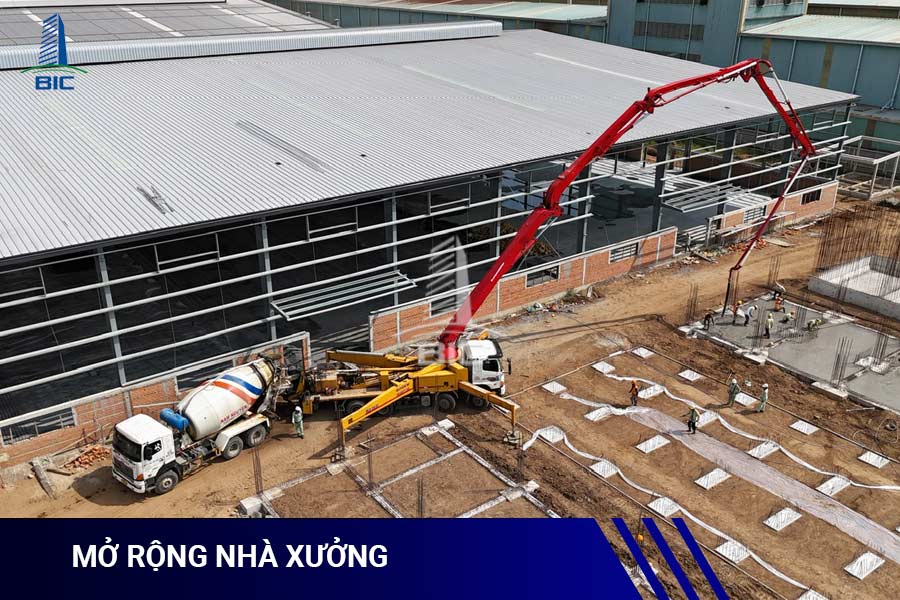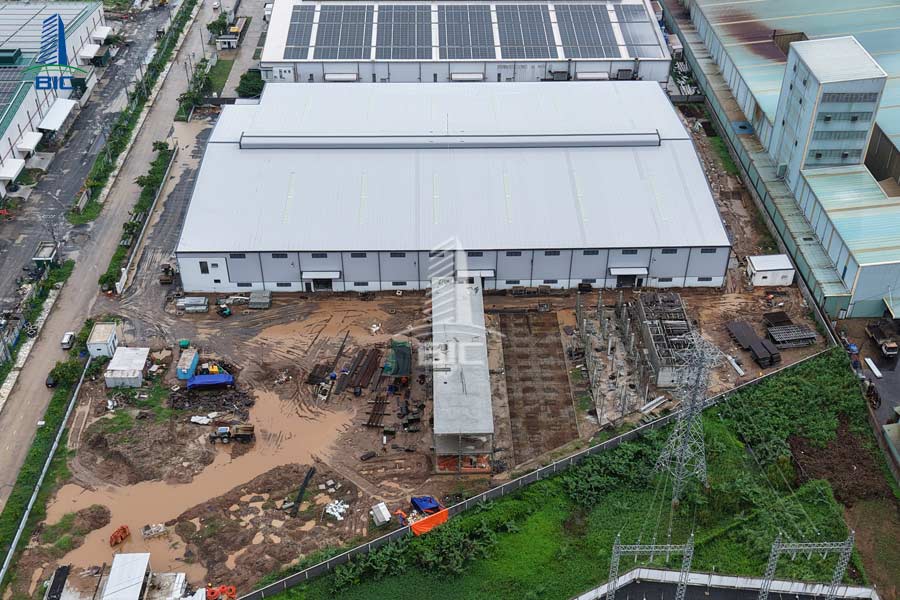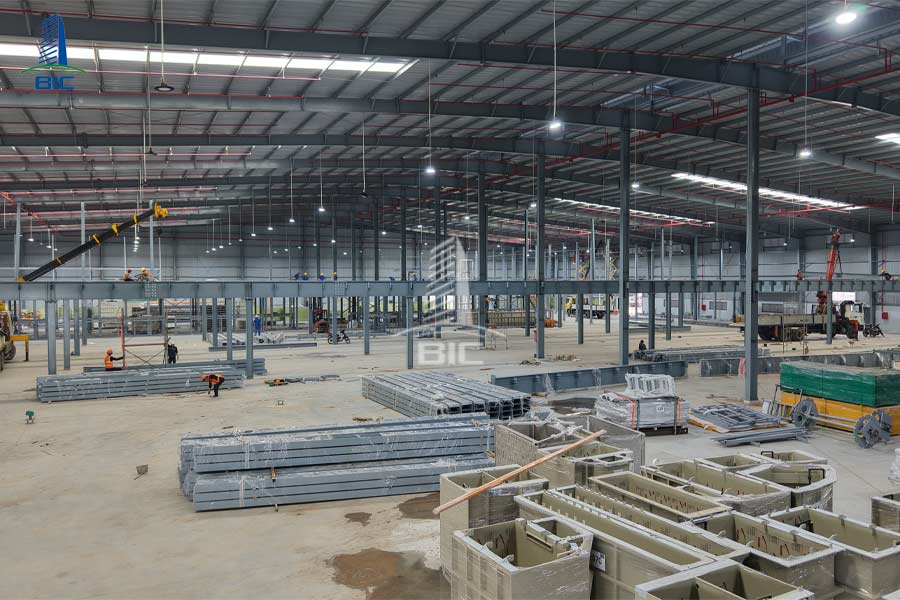
As production activities grow, expanding a factory becomes an inevitable solution to meet the increasing demand for capacity, storage, and production lines. Compared to building an entirely new facility, expansion helps businesses optimize costs, take advantage of existing infrastructure, and shorten implementation time. However, this process is not simple; it requires careful planning from site survey and factory design to construction and final inspection.
In reality, many businesses face difficulties during expansion because they fail to fully assess the load-bearing capacity of foundations, steel structures, or existing technical infrastructure. This often leads to issues such as overloaded electrical and water systems, disrupted material flow, or non-compliance with fire safety regulations. On the other hand, when expansion is thoroughly and systematically prepared in the design and construction stages, it ensures smooth operation, enhances production efficiency, and guarantees long-term safety.
With extensive experience in implementing industrial projects across multiple sectors, BIC supports businesses in consulting, designing, and executing factory expansions. Beyond focusing on technical and functional aspects, BIC also emphasizes sustainable development, energy efficiency, and regulatory compliance delivering solutions that optimize both costs and operational performance.
Expanding a factory is a critical strategy that enables businesses to respond promptly to growth demands. When production output and storage capacity exceed current limits, expansion provides opportunities to increase production capacity without investing in an entirely new facility.
First, expansion allows for effective use of existing infrastructure. Foundations, electrical systems, water supply, and internal roads are already in place, which saves significant costs and time compared to new construction. This is especially advantageous when businesses need to scale up production quickly to meet large contracts or expanding markets.
Beyond cost efficiency, expansion provides a competitive edge. A scientifically designed factory with phased development capability allows businesses to better organize production lines and warehouse management. This ensures continuity in operations and minimizes risks of production disruptions.
Finally, factory expansion reflects a company’s long-term vision. Instead of only addressing short-term needs, expansion planning tied to sustainable development strategies helps businesses be more proactive against market fluctuations, thereby enhancing credibility and strengthening industry position.

Before expansion, surveying and evaluating the current factory’s condition is the most crucial step. Businesses must check the load-bearing capacity of foundations, the durability of steel frames, and the condition of roofing and walls. If the structure is deteriorated or cannot handle additional loads, expansion poses significant safety risks.
For instance, when adding extra floors, old foundations and steel frames must be reinforced to avoid subsidence or collapse. It’s also important to review drainage, waterproofing, and material durability, as these directly affect the longevity of the expanded facility.
Expansion is not only about adding space, it must align with the overall master plan. Poorly designed expansions may cut through production lines, overlap warehouses, or extend material flow unnecessarily, leading to inefficiencies.
The expansion plan must be based on actual functional needs: arranging production areas, auxiliary spaces, raw material storage, and finished goods warehouses according to streamlined movement flows. Future adaptability for further expansion should also be considered to avoid cramped or inflexible layouts.

Infrastructure is key to effective operation post-expansion. Electrical, water, lighting, ventilation, and especially fire protection systems must be upgraded in line with the new scale.
In many cases, businesses focus only on increasing space while neglecting infrastructure upgrades, resulting in overloaded electricity, insufficient water supply, or non-compliance with fire safety codes. This not only poses risks but also raises long-term repair costs. A proper expansion design must therefore include synchronized planning of water supply and drainage, HVAC systems, and fire detection and suppression systems.
Any construction or expansion activity must comply with legal regulations. Businesses are required to obtain additional construction permits, conduct environmental impact assessments, and meet standards for occupational safety, fire safety, and national technical codes.
Ignoring this step could lead to project suspension, delays, and significant financial losses. Moreover, non-compliance with design and construction standards increases safety risks during operation. Hence, legal preparation is an indispensable requirement before implementation.
A successful expansion plan always includes a reasonable cost estimate and project schedule. Businesses must balance upfront investment with long-term benefits. For example, choosing high-quality materials may raise construction costs but significantly reduce maintenance and operational expenses later.
At the same time, the construction timeline must be carefully planned to avoid disrupting ongoing production. For companies with continuous orders, even a few days of downtime could cause major losses. Staged construction or nighttime work may be effective solutions in such cases.

One of the foremost requirements in expansion is ensuring consistency with the existing structure. If the new section does not harmonize with the old one in terms of structure, height, roof slope, or drainage systems, issues such as leaks, roof sagging, or spatial imbalance may arise.
Consistency also applies to the master plan: production zones, warehouses, offices, and auxiliary facilities must connect seamlessly to ensure smooth operations. A disjointed design could disrupt material flow, reduce efficiency, and increase operational costs.
Building materials directly impact durability and maintenance costs. For factory expansions, using pre-engineered steel, insulated roofing, or high-quality reinforced concrete helps ensure strength, load resistance, and long-term cost savings.
Choosing cheaper materials may lead to faster deterioration, cracks, corrosion, or leaks making repair costs far exceed initial savings. Investing in suitable materials from the start is therefore the best way to secure long-term economic efficiency.
In today’s industrial trends, green and energy-saving solutions are increasingly prioritized. Expanded factories can incorporate skylight roofing to reduce daytime lighting costs, install solar panels to generate renewable energy, or design natural ventilation systems to ease the burden on air conditioning. These solutions not only lower operational expenses but also help businesses meet environmental standards, offering advantages in partnerships with international clients that value sustainability.
Safety is always a top priority in industrial facilities, especially during expansion. Design must comply with safety standards for emergency exits, fire alarms, and automatic suppression systems.
Additionally, layouts should minimize fire risks by separating flammable material storage from production zones. Integrating safety from the design stage protects workers, reduces potential damages, and ensures stable and sustainable operations.

Factory expansion is a complex process requiring coordination from site survey and technical design to construction and quality management. A professional design construction firm ensures the entire process is safe, effective, and compliant with regulations.
Experts analyze existing structures, propose appropriate solutions, and prepare expansion plans that align with the current facility. They also ensure compliance with fire safety, occupational safety, and environmental standards. With extensive experience in large-scale projects, reputable firms can optimize construction costs, shorten timelines, and maintain long-term quality.
Furthermore, professional firms play a critical role in monitoring and controlling risks, allowing businesses to focus on production without worrying about technical or legal issues.
Factory expansion is not just about adding production space, it is a strategic move that determines a business’s long-term growth capacity. Thorough assessment of existing conditions, space planning, infrastructure, costs, and safety considerations helps minimize risks, optimize investments, and maintain uninterrupted operations.
To achieve this, partnering with a reputable design and construction firm is the most sustainable solution. With expertise and skilled engineers, BIC has supported many businesses in consulting, designing, and executing factory expansions delivering safe, modern, and cost-optimized facilities. This foundation enables enterprises to enhance production capacity, strengthen credibility, and remain competitive in the industrial market.